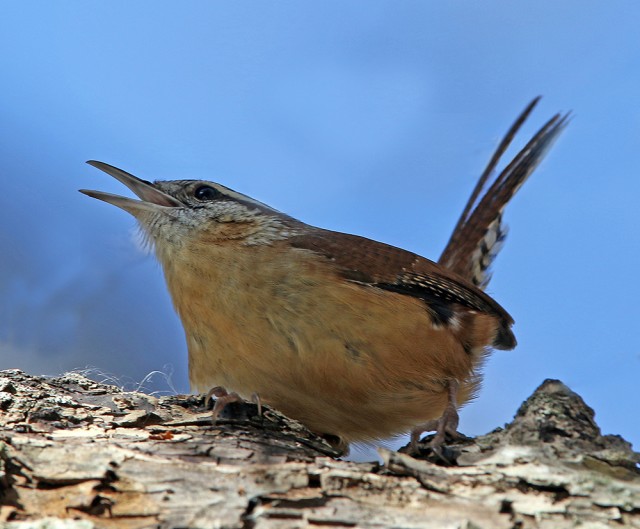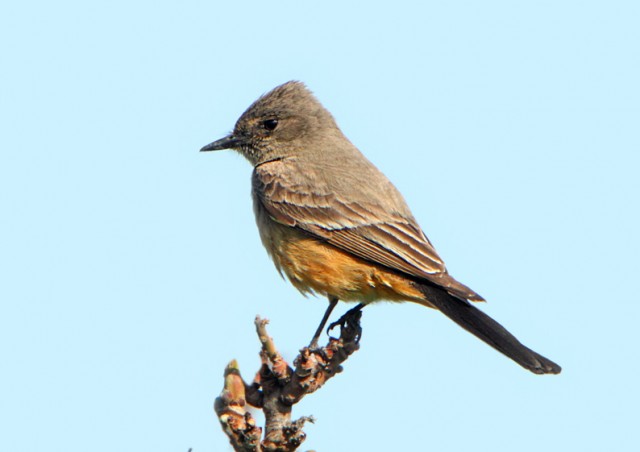
A few years ago, I often woke to the rolling ‘teakettle-teakettle-tea’ song of the Caroline Wren, but now these singing powerhouses seem gone from our part of Bee County. This shy species can be hard to see, but it delivers an amazing number of decibels for its size. I was delighted to find a small population of these cinnamon-colored beauties happily foraging in the trees along Poesta Creek in Veteran’s Memorial Park during the recent Great Backyard Birding Count. Robert Benson photo.
19 Feb 2016 – Where the Birds Are … And Where they Aren’t
The Great Backyard Bird Count of 2016 was held last weekend and by all accounts it was a success. Over 145,000 checklists of birds were submitted. More than 16 million individual birds were counted around the world. And 5,215 species were observed! Since checklists can still be submitted through March 1st, all these numbers may still go up.
Locally, six Bee County birders submitted 21 checklists during the four day count. Together we tallied up 77 species in our county. Pat yourselves on the back, Bee County birders! You can see the species list at birdcount.org by clicking on “Explore Data” and entering Bee County as the location.
What was most surprising to me was the species that wasn’t on the list: the Purple Martin. Nobody in our county reported seeing Purple Martins. Of course, a few are turning up on the upper Texas Coast. And two checklists reported a total of 13 individual martins in Victoria. The next closest location in South Texas was all the way down in the Rio Grande Valley. There four separate checklists reported Purple Martins. The locations were San Benito (2 martins), Weslaco (10 martins), and Bentsen-Rio Grande State Park (one martin reported by 2 different observers). There was a whole lot of gray area on the map between Victoria and the Valley where no Purple Martins were detected. What is going on with this species? They are supposed to arrive around Valentine’s Day (and we have seen them in January), so where are they? Our area’s Purple Martins are definitely late this year.
Dove numbers in general seem to be down. And where is the Common Ground –Dove? We only reported four of these doves in Bee County during the GBBC count days. For a species that is a resident of South Texas, these chunky little doves seem a bit thin on the ground this winter.

The Say’s Phoebe is an uncommon winter visitor in Bee County. It loves the open country found around the Amish Farms and the prairies north and east of Pawnee. This flycatcher is a tail-wagger like other phoebes and it loves to perch on fence wires waiting for insects to happen by. This individual was discovered just off County Line Road on the last day of the 2016 Great Backyard Birding Count. Wikimedia Commons photo.
However, a species we have not been seeing lately did turn up in two locations. It was the Carolina Wren. We have had them on our farm in the years prior to the current drought, but we haven’t heard a peep out of them for the last three years. We thought they had died or left the county. But perhaps they aren’t gone, after all. They seem to have simply retreated to the moister habitats they prefer. On a small drainage crossing a county road north of Pawnee, we heard two calling. And in Veteran’s Memorial Park in Beeville, we saw and heard four. These four were on the Poesta Creek. I think if we just search more of our creeks, we will find our missing wrens.
A few species were reported by only one observer out of the six Bee County participants: Judi Williamson saw the only Anhinga, Brad Newton reported the only Rock Pigeon (feral pigeon), Robert and I saw the only Say’s Phoebe, Linda Vegh had two Sharp-Shinned Hawks at her bird feeder, Ruth Davies reported an Empidonax flycatcher, and Hilbert McLaechelin, Jr. had the high count of 13 White-winged Doves. And oddly enough, the only Northern Bobwhites were submitted by an anonymous observer!
Sometimes, an absence of birds on a count is as telling as having a high number of species. In fact, the award for “the toughest GBBCer on the planet” goes to Brian Zawadski who entered four complete checklists for Nunavut, Canada’s most frozen province. All the checklists included all the birds he saw: Only one species each time. Thus he documented where the birds ARE NOT! Can you guess what species Brian saw? (Go to birdcount.org and hit explore data and enter Nunavut to find out.)
Besides providing a snapshot of where the world’s birds are in February, the GBBC gives photographers a chance to snap their best shots of birds and enter them in the GBBC Photo Contest. Many people have done just that and you can see the photos that have been entered so far at birdcount.org (scroll down to 2016 Contest Photos.)
Here are some of my favorites you might want to look for: a greedy Blue Jay trying to carry off two peanuts in Connecticut, a Calliope Hummingbird in Texas, lots of Yellow-rumped Warblers from all over the US, Redheads in love in Florida, a Pileated Woodpecker with most of his head in a hole in Ohio, a gorgeous male Snowy Owl in Ontario and a very glum-looking Golden-crowned Kinglet in Saskatchewan. In the People and Birds category, I was quite taken with photo of a child feeding gulls in South Carolina, and a dizzying shot of a birder on a sea cliff in California. There are photos of beautiful birds from all over the world, too. Look for the Eurasian Hoopoe in Bhutan and the Little Corella from Australia. Click on the “Like” button to let the photographers know you appreciate their efforts.
Whether you submitted a checklist, took photographs, or simply explored the resulting data, the Great Backyard Bird Count thanks you!
If you would like to offer comments, please click through to the discussion page
